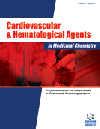- Home
- A-Z Publications
- Cardiovascular & Hematological Agents in Medicinal Chemistry (Formerly Current Medicinal Chemistry - Cardiovascular & Hematological Agents)
- Previous Issues
- Volume 6, Issue 3, 2008
Cardiovascular & Hematological Agents in Medicinal Chemistry (Formerly Current Medicinal Chemistry - Cardiovascular & Hematological Agents) - Volume 6, Issue 3, 2008
Volume 6, Issue 3, 2008
-
-
Editorial [ Hot Topic: Structural Basis for Variable Lytic Susceptibility of Fibrin Bridging Structure with Function in Fibrinolysis (Guest Editor: K. Kolev) ]
More LessBy K. KolevCardiovascular and cerebrovascular diseases continue to be a major public health burden worldwide. According to the WHO data the mortality related to atherothrombosis is the leading cause of death responsible for 22.3% of the total deaths in the world preceding infectious diseases (19.1%) and neoplasms (12.5%) [1]. Some of the improvements in death rates seen in many developed countries may be partly attribut Read More
-
-
-
The Biochemical and Physical Process of Fibrinolysis and Effects of Clot Structure and Stability on the Lysis Rate
More LessAuthors: J. W. Weisel and R. I. LitvinovThe effectiveness of fibrinolysis results from the combination of regulated enzymatic activity and the physical properties of the fibrin scaffold. Physiologically, clots or thrombi are dissolved from within via internal lysis. In contrast, with therapeutic thrombolysis, lytic agents are introduced at one surface and lysis proceeds across the thrombus. In the latter case, there are complex changes that take place at the lysis front in a Read More
-
-
-
Searching for Differences between Fibrinogen and Fibrin that Affect the Initiation of Fibrinolysis
More LessAlthough in a gross sense fibrin is merely a collection of fibrinogen molecules packed together in bundles, numerous small structural differences can arise as a result of the conversion of the soluble precursor into the gelled product. Some of the consequences are obvious, others more subtle. In one way or another, all these changes are the result of a sequence of events that includes the release of the fibrinopeptides A and B, Read More
-
-
-
The Involvement of Blood Coagulation Factor XIII in Fibrinolysis and Thrombosis
More LessAuthors: L. Muszbek, Z. Bagoly, Z. Bereczky and E. KatonaIt has been known for a long time that blood coagulation factor XIII (FXIII) is essential for maintaining haemostasis, its deficiency leads to severe bleeding complication. Biochemical studies have revealed that FXIII is a key regulator of fibrinolysis and, in addition to its role in haemostasis, it has also been implicated in the pathology of arterial and venous thrombosis. Most recently, the polymorphisms in the FXIII subunit genes an Read More
-
-
-
Alterations of Fibrinogen Structure in Human Disease
More LessBy M. HoffmanProducts of normal and pathologic metabolism can react with proteins to cause covalent modification. When such modifications affect fibrinogen they can potentially alter fibrinogen function. Those that have been best studied are oxidation, nitration, homocysteinylation and glycation. It appears that the clottability of fibrinogen is maintained unless the degree of modification is extensive. However, modest degrees of fibri Read More
-
-
-
Fibrin Binding and the Regulation of Plasminogen Activators during Thrombolytic Therapy
More LessAuthors: C. Longstaff, S. Williams and C. ThelwellFirst generation thrombolytics (streptokinase and urokinase) had no fibrin binding capabilities and caused systemic plasminogen activation with concomitant destruction of haemostatic proteins. A primary driving force behind the development of the second generation plasminogen activator tissue plasminogen activator (tPA or alteplase) was its ability to bind to fibrin and target thrombolysis. Although in vitro assays highlighte Read More
-
-
-
Role of Cellular Elements in Thrombus Formation and Dissolution
More LessBy N. WohnerAlthough fibrin forms the core matrix of thrombi, their structure depends also on the cellular elements embedded in its meshwork. Platelets are essential in the initial stages of thrombus formation, because they adhere and aggregate at sites of blood vessel wall injury and then serve as a surface for coagulation reactions, the overall rate of which determines the final structure of fibrin. In addition, platelets affect fibrinolysis Read More
-
Volumes & issues
-
Volume 23 (2025)
-
Volume 22 (2024)
-
Volume 21 (2023)
-
Volume 20 (2022)
-
Volume 19 (2021)
-
Volume 18 (2020)
-
Volume 2 (2020)
-
Volume 17 (2019)
-
Volume 16 (2018)
-
Volume 15 (2017)
-
Volume 14 (2016)
-
Volume 13 (2015)
-
Volume 12 (2014)
-
Volume 11 (2013)
-
Volume 10 (2012)
-
Volume 9 (2011)
-
Volume 8 (2010)
-
Volume 7 (2009)
-
Volume 6 (2008)
-
Volume 5 (2007)
-
Volume 4 (2006)
Most Read This Month
Article
content/journals/chamc
Journal
10
5
false
en


